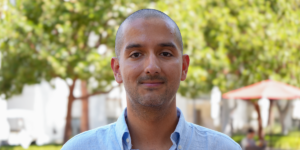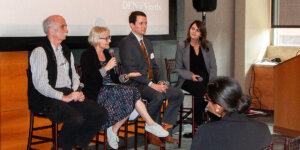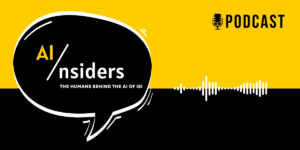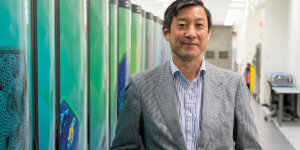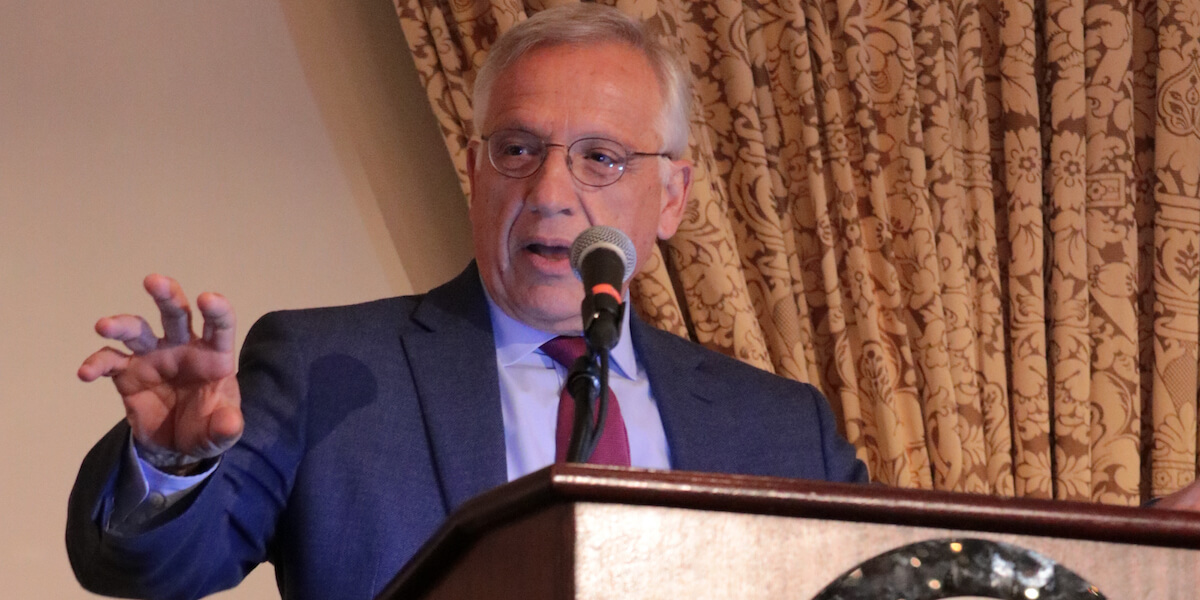
Dean Yannis C. Yortsos speaking at the State of the School (Photo/Peter No)
In his Sept. 24 State of the School address, Dean Yannis C. Yortsos celebrated several important milestones, including achieving gender parity in USC Viterbi’s entering undergraduate class; the 10th anniversary of the Grand Challenges Scholars Program, USC Viterbi’s integral role in its success and how it is becoming the blueprint for the Engineer of 2020; a new student world record by the USC Rocket Propulsion Lab; and the completion in time of a $500 million fundraising campaign. He then touched on the themes of competence and character (namely the attributes of trust), as fundamental attributes for all engineering students, and for USC Viterbi as an organization as a whole, for the greater good of society.
The milestones cited reflect USC Viterbi’s commitment to “changing the conversation about engineering, who we are, what we do, and what we look like”:
- The entering undergraduate class is 50% women, a historic school high.
- The school counts the largest number of women graduate students in the nation.
- The Grand Challenges Scholars Program, conceived in 2009 by Duke Engineering, Olin College and USC Viterbi, is becoming the blueprint of today’s engineering graduate, by emphasizing not only technical competence, but also ethical and societal attributes, namely attributes of trustworthiness, to be increasingly asked by society on our students and our institutions.
- Fifty years after alumnus (M.S. 1971) Neil Armstrong’s historic moonwalk, a group of engineering students at the USC Rocket Propulsion Lab became the first student team in history to design, build and successfully launch a rocket past the Karman line – the recognized boundary between Earth’s atmosphere and space.
“Our students’ success was the culmination of many years of hard work,” Yortsos said. “It personified their grit, ingenuity, perseverance and teamwork, all important attributes to thrive in today’s world.”
In today’s fast changing world, engineering graduates will need more than just technical skills. They and the organizations for whom they work will need to possess what author Stephen Covey terms “cores of credibility,” including character and competence: the building blocks of trust. These will help us keep changing the conversation about engineering.
The following are modified excerpts from Dean Yortsos’ remarks:
On this year’s undergraduates
During the past 114 years of the School of Engineering’s existence, tens of thousands received their engineering degrees from USC. Today, we count more than 77,000 living engineering alumni. They have built the world of the last century and of the beginning of the 21st. But the academic year 2019-2020 marks another, different and historic milestone. Because fall 2019 marks the year when the entering undergraduate class reached, for the first time in our history, gender parity!
On Aug. 22, 2019, we announced at the new student convocation, that the entering freshman class consists exactly of 50% women (206 out of 412)! This is a historic record, one that will not be broken again. One due to the collective work of all of you. And one that distinguishes us among many engineering schools. It is a record worth treasuring, worth cherishing, worth celebrating. It reverberates loudly: the message that we are constantly changing the conversation about engineering – who we are, what we do and what we look like.
This stellar class has many other strong distinctions as well: 171 students, or nearly 42%, are University Scholars; 62 are National Merit Scholars, 19% are from underrepresented minorities; 17% are first-generation students: they come from 30 different countries and from 39 different states. It is a class that will engineer a better world for all humanity.
On the NAE Grand Challenges Scholars Program
This year, we are celebrating another milestone. It is the 10th anniversary of the NAE Grand Challenges Scholars Program, conceived and pioneered in 2009 by USC Viterbi, Duke Engineering and Olin College. This program, now adopted by more than 120 schools globally and growing fast, has become an NAE signature program. In the last few years, about 50 or so Viterbi seniors have graduated each year with such a distinction, which also comes with an NAE certificate. The GCSP is essentially summarized in the five mindsets, from interdisciplinary research and innovation to cultural understanding and to service learning.
- Hug the exponential: Acquiring superb technical skills to lead the exponentially changing technology. Our graduates must be the masters of the technological evolution and have the skills and knowledge to shape it and lead it.
- Engineering +: The empowering and convergent nature of engineering for all segments of our population (and one that eliminates various emergent divides) ask us to enlarge our view of engineering. Engineering, at the center of advances in many disciplines (read Engineering + X, with X being increasingly human-centric), spells out what we do, and by extension who we are, and what we look like.
- Innovation in its broadest sense: To help create new ideas, new markets, new jobs, new best practices, and to re-design oneself. All of which are crucial ingredients to thrive in a constantly changing world.
- A cultural mind: Strong cultural awareness, with culture broadly interpreted (spanning from local to global, past to present and present to future).
- Heroic engineering: Reflecting the beneficial impact of engineering to society (including the importance of technology ethics, where one needs not only worry about what is smart and legal, but also by what is right).
These mindsets encompass the brain, and they encompass the heart; they encompass competence and character. They encompass character and competence, the two fundamental attributes of trust. Indeed, Stephen Covey, in his book “The Speed of Trust” cites four Cores of Credibility:
CHARACTER
- Integrity (humility, courage)
- Intent (motive, agenda, behavior)
COMPETENCE
- Capabilities (talent, attitude, skills, knowledge)
- Results (performance- past, current, anticipated)
These mindsets, these attributes of competence and character will be the fundamentally attributes for the 21st century engineer: Exceptionally skilled technically, immersed in convergence and multidisciplinary, capable and confident for constant innovation and re-invention, having a deep understanding of human cultures and their behavioral drivers, and steeped with the ethical attributes in decision-making and the societal impact of engineering. These are people one can trust. This is a fundamental part of changing the conversation about engineering. And this overarching appealing and compelling message is the one that attracts talented students to engineering and to USC Viterbi, from all segments of our population, thus leading to the new heights we are witnessing.
On the Global Grand Challenges Summit (London, September 13-19, 2019)
An important part of each Summit is the engineering student plan competition. This year 15 teams worldwide – five each from the US, the UK and China – competed. They were selected by prior qualifying national competitions. More than 30 such teams participated in the US playoffs, organized by our own school. I am pleased to report that one of the five teams representing the US was a USC Viterbi team, Marlink. This team of rising seniors, working on underwater robots, led by EE major Roxanna Pakkar, was an all-female team, and the only such in the Global Summit. It marked another historic and global first for Global Summits, contributing to the changing of the conversation about engineering and loudly declaring that we are staying true to our promise.
On helping people in crisis through engineering innovation
Last year, the Astani Department of Civil and Environmental Engineering offered a new course, CEE 499: Innovation in Engineering Design for Global Challenges. This course aims to teach engineering students how to design products, services and technologies by using a human-centered approach that helps solve the needs of real people in the middle of serious human crises. Its motto: Lives not Grades. The course, led by CEE Professor Burcin Beceric-Gerber, along with a talented team of faculty and staff, focused on the plight of war refugees in the Greek island of Lesvos. It was supported by the Provost office, and by a number of Viterbi alumni and friends. The course had one of the most diverse enrollments for an engineering course, with students from as many as 13 disciplines and six USC schools. It also formed the theme of the Min Family Challenge last year.
The course was the perfect embodiment of the five mindsets of growth: Technical competence, Engineering+, Innovation (with a social responsibility angle), Cultural Awareness, Heroic Engineering: Five mindsets in competence and character, five mindsets exuding trust. It was transformative to the students, faculty, and the people in distress. It demonstrated the power of engineering and technology in solving real human problems. It uplifted the recipients of our outreach, the inhabitants of the camps, and the local residents of the island. Moreover, the course helped restore trust to the mission of universities, trust to its engineering students, and charted a new transformative path for engineering in solving real people’s problems.
On inclusiveness (eliminating distances in space, time, culture, opportunity)
In 1966, USC Viterbi alumnus Andrew Viterbi had an ingenuous idea for data transmission, the Viterbi Algorithm. We celebrated its 50th anniversary three years ago. The Viterbi algorithm is the fundamental cornerstone for digital communications. It has made possible unparalleled technological achievements, such as space exploration. But it is also much, much more than that. I do not know if it has been noted before (although the “Flat World” of Tom Friedman comes to mind) but in my view, arguably the most important impact of the Viterbi algorithm is that it eliminated distances: distances in space, and distances in time, thus distances in cultures, distances in inclusiveness, and distances in opportunity. Andy Viterbi made the world one big human neighborhood.
It is natural then, that the Viterbi School (the home of the Viterbi algorithm that has brought people closer together) has an unparalleled global reach. It is also no accident that we fiercely embody such values, where distances are eliminated: distances in hearts and in minds. It is then not an accident that this fall, and despite global tensions, tariff wars and other uncertainties, the entering graduate class is as strong and as international as any in recent memory. Thanks to that strength, our enrollments are equally strong. And with our graduate student body leading the nation in the number of women engineering graduate students, another point of pride for all of us.
On diversity
As part of such commitment to equity, diversity and inclusion, we led in 2015 a national initiative to increase the diversity of engineering schools. Spawned in June 2015 and completed in 2016, this has now become an ASEE (American Society for Engineering Education) initiative, accepted by more than 230 engineering schools nationwide. The initiative commits engineering schools to four tasks: Creating a comprehensive diversity plan; outreach to K-12; outreach to community colleges and four-year degree institutions; and increasing faculty diversity. The Viterbi School, having established in 2016 the office of Vice Dean for Diversity and Strategic Initiatives, has been a national leader in the pursuit of these goals. And earlier this year, Viterbi was singled out among a handful of other engineering schools as an exemplary school for its pursuit of equity, diversity and inclusion.
On faculty accolades
Two of our distinguished faculty, Mahta Moghaddam of ECE and Behrok Koshnevis of ISE, were recently elected to the National Academy of Engineering. While two others in our faculty, Ellis Meng of BmE and Mike Waterman, with a joint appointment in CS, were elected to the National Academy of Inventors. These crowning achievements are a testament to our faculty quality and ingenuity. These elections continue a long trend: Since 2008, 12 of USC faculty were elected to the NAE and 14 Viterbi faculty to the NAI. I look forward to Mahta’s and Behrok’s NAE induction next week in Washington, D.C. The quality of our faculty ranks has been further strengthened with the arrival at USC of many new faculty, including two other NAE members: Ret. Gen. Ellen Pawlikowski, Ph.D. in ChE, who is joining USC as Judge Widney Professor, and new Provost Chip Zukoski, also a ChE Ph.D. I must say that we have the right chemistry! We also welcome yet another distinguished new Viterbi faculty member, USC new President Carol Folt, with a joint appointment in CEE. The past four USC Presidents had or have faculty appointments in Viterbi?
I should also single out some other important faculty distinctions, all since April 2019: Lucio Soibelman was elected in the National Academy of Construction; Jong-Shi Pang won the 2019 von Neuman Prize; Paul Rosenbloom won the Herbert A. Simon Prize for Advances in Cognitive Systems; Costas Synolakis was the recipient of the 2019 International Coastal Engineering Award; Salman Avestimehr won the IEEE Information Theory Society James L. Massey Research & Teaching Award; Azad Madni won the INCOSE Founder’s Award, as well as the ASEE/AIAA John Leland Atwood Award; and Eun Ji Chung and Paul Bogdan were invited participants to the NAE Frontiers of Engineering Symposium (FOE), which is considered a “junior NAE.”
On engineering and technology
Our exponentially changing times demand that we keep innovating, every day, to strengthen our educational programs; one such effort is integrating data sciences across the engineering curriculum. Many now view engineering and technology as indispensable as a liberal arts education. USC Viterbi is responding by offering a new array of MS degrees in Informatics, by supplementing the degree of any Dornsife student with a strong technology and engineering segment, in the area of data sciences, as well as with the many programs in our Information Technology Program (ITP), now led by Jeff Miller. Engineering and technology’s convergent and ubiquitous nature has led to its becoming quintessential to the education of practically every student and professional, regardless of background or major.
As you know, in the pursuit of our mission, we use a definition for engineering and technology that transcends traditional stereotypes: Technology is leveraging phenomena (and systems, devices and tools, and combinations thereof) for useful purposes (including discovering of new phenomena)
I cannot but remark that implicit in the definition above are again the two themes of trust: competence (leveraging of phenomena) and character (useful purposes). Historically, and in increasing order of complexity, the phenomena of interest included physical, chemical, and geological, phenomena. In recent years, the increasing power of technology has allowed us to engage with higher complexity, associated with biological phenomena, and more recently, through the unprecedented advances in computational power and data sciences, with fast emerging couplings with social and behavioral phenomena as well. I believe that this new expansion to behavioral and social phenomena is a natural extension of the enabling power of engineering and technology. And just as we get our students versed in the natural sciences, we might consider expanding those offerings to social sciences as well.
It is in this spirit that we envision, and already have developed in some areas, multiple strong partnerships between USC Viterbi and other USC schools, as well as within the various disciplines of engineering within the Viterbi School. Such initiatives include the possible creation of virtual academic entities, for example between Viterbi and Keck, in biomedical engineering, between Viterbi and Price in civil and environmental engineering (including the recent Center on Sustainability), or Viterbi and Gould, in the CS areas of government and law, privacy and security. Earlier this year we established a successful such program in the nation-leading Games program by creating a virtual department between Viterbi and the School of Cinematic Arts.
I will also make a parenthesis to stress the most important and unique differentiator for USC Viterbi, absent from practically any other university: The Information Sciences Institute (ISI) and the Institute for Creative Technologies (ICT). Combined with the Department of Computer Science, they create a triad of excellence in computer science (CS@SC), unparalleled in the nation. More importantly, they contribute to national needs, including defense, while their versatility in research projects from basic to applied to systems, allows for a wide spectrum of partnerships with many departments and schools. These two centers are essential and indispensable components of USC Viterbi.
On the ethical dimension
The very definition of technology, leveraging phenomena for useful purposes, encompasses unintended consequences, which are increasingly powerful. This urgently calls for technology ethics, the development of character. Which brings up again the issues of trust to engineering and technology. Ethical decision-making lies at the intersection of smart, legal and ethical. But this is also the intersection of competence and character, the two attributes of trust. Today, the extraordinary growth of technology brings up unprecedented new problems with deep ethical concerns. It has become imperative, therefore, for us to embark in significant efforts to help our students understand their responsibility in the development and stewardship of their increasingly potent technologies. This calls for the creation of new dimensions in our curricula and along with it the re-invention, rebranding and refocusing of the Engineering Writing Program.
On innovation
Achieving technology goals is ultimately based on innovation and entrepreneurship and the dissemination and adoptation of best practices. Cultivating a thriving environment for innovation and entrepreneurship, with its underlying mindsets of the freedom for experimentation, the launching of bold new initiatives, and of grit and perseverance, continues being an important and fundamental tenet of the Viterbi School. Vice Dean Ellis Meng, appointed to succeed Dr. Andrea Belz, who is now on assignment at the NSF, will continue expand all aspects of the Viterbi startup and technology ecosystem, including the establishment of incubation processes and facilities, such as the Viterbi Startup Garage. We continue to aspire to be the leading educational institution in Silicon Beach in shaping technology innovation and entrepreneurship.
On philanthropic support to our mission
I started my speech by stressing historical milestones and the importance of trust. Perhaps none of these is better manifested than in philanthropy. As many of you probably know, at the end of June 2019, USC Viterbi successfully reached its $500 million campaign target, likely the largest ever for an engineering school, and another historic milestone this year. The advancement team, led by Senior Associate Dean Mary Ann Schwartz, raised an annual average of about $55.5 million. I am proud of the effort and focus that helped us reach this very ambitious goal, particularly because USC Viterbi had successfully completed a prior fundraising initiative between 2001-2008. The recipients of such extraordinary philanthropy, faculty and students, current and in the future, with 20 new chairs and 59 new scholarships established, stand to benefit greatly from the fruits of this campaign.
On space and the moon
On July 20, 1969, Neil Armstrong became the first person to walk on the moon during the Apollo 11 mission. After he returned to earth, he realized that he was missing something: a master’s degree from USC Viterbi! This, he earned indeed a year later from our Aerospace Engineering Department. We celebrate Neil Armstrong and his relation to the school through his statue at the Epstein Family Engineering Plaza.
Fifty years later, a group of USC engineering students continued the late Armstrong’s legacy. In April 2019, the USC Rocket Propulsion Lab became the first undergraduate student team in history to design, build and successfully launch a rocket past the Karman line – the recognized boundary between Earth’s atmosphere and space. Their rocket, Traveler IV, reached a height of 339,800 feet, more than doubling the previous record set just two years earlier by another USC RPL team. Our students’ success was the culmination of many years of hard work. It personified their grit, ingenuity, perseverance and teamwork, all important attributes to thrive in today’s world. This is another historic milestone (the fifth) for the school this year.
On trust as part of the excellence of an organization
Today’s world of exponential changes exerts significant strains on what we collectively call organizational “culture.” They demand constant agility, growth and adaptation. The schematic in your postcard, one that you have seen before, shows the changing world, and one that adapts slowly (the straight line- one that I call a “fixed mindset”). The two curves apply to individuals, but also to organizations. Now, the distance between the exponential and the organizational mindsets that fail to react fast (the straight line), also increases exponentially fast. For us as an organization to remain agile and nimble, to adapt and lead, requires us to “hug the exponential” collectively. It is only then that we remain true to our students, our faculty, our staff, our constituents, namely all those we serve, and the promises we have made to them.
But such agility to change collectively, to constantly transform and innovate can only be accomplished if there is a strong organizational culture of trust. Why? Because lack of trust creates friction, which slows us down, disables adapting, makes us indecisive and suspicious, prevents us from growing: in the words of Covey, in his book “The Speed of Trust:” “We pay a tax when trust is absent.” Trust is a required ingredient to move fast in our fast changing times.
On excellence
As the university embarks in a new chapter, with a new leadership at the president’s level, with President Folt and Provost Zukoski, the Viterbi School will be an indispensable partner school to help advance the university vision by enabling all other disciplines in a quest for excellence, in a quest for trust. Having reached many historic milestones this year, the school aims to keep reaching higher, to help educate the new engineer, to advance Engineering a Better World for All Humanity. This constant is as immutable and enduring.
Quantum Physicist David Deutsch said: “Problems are inevitable. But all problems are solvable.” I fully endorse this aspirational mindset, one that reflects competence and character.
I invite you to join me in this commitment of trust. Thank you, and Fight On!
Published on September 27th, 2019
Last updated on April 21st, 2025




